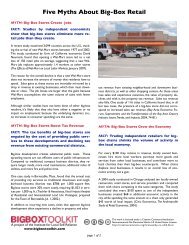Building Healthy Soils with Compost to Protect Watersheds
Building Healthy Soils with Compost to Protect Watersheds
Building Healthy Soils with Compost to Protect Watersheds
Create successful ePaper yourself
Turn your PDF publications into a flip-book with our unique Google optimized e-Paper software.
Current Watershed Problems<br />
Intense rain events can <br />
overwhelm traditional <br />
conveyance systems. <br />
Adding green infrastructure <br />
through compost-‐amended <br />
soils and bioretention <br />
systems help slow and clean <br />
runoff. <br />
Pho<strong>to</strong>: Seattle Public Utilities <br />
Eutrophication describes the over <br />
enrichment of aquatic systems from <br />
excessive inputs of nutrients, resulting in <br />
increased populations of phy<strong>to</strong>plank<strong>to</strong>n <br />
and algae, and ultimately lowering <br />
dissolved oxygen (DO) in the water <strong>to</strong> a <br />
level that cannot sustain life. 8 When the <br />
phy<strong>to</strong>plank<strong>to</strong>n and algae die, bacteria <br />
decompose them, which consumes large <br />
amounts of oxygen that other aquatic life <br />
(such as crabs and fish) need for survival. 9<br />
Runoff from agricultural, urban, and <br />
suburban lands cause the excessive <br />
nutrient levels found in the Chesapeake <br />
Bay <strong>to</strong>day. 10<br />
Erosion & Sedimentation: During <br />
initial phase construction, land is cleared <br />
of vegetation and <strong>to</strong>psoil, making it very <br />
susceptible <strong>to</strong> erosion. 11 Erosion disturbs <br />
drainage areas and natural environments <br />
by transporting loose particles of clay, silt <br />
and sand in<strong>to</strong> receiving water bodies (i.e. <br />
sedimentation). While weathering of <br />
rocks and erosion is a naturally occurring <br />
process, a surplus of sediment has <br />
detrimental aquatic effects, harming fish, <br />
oysters and underwater grasses in the <br />
Chesapeake Bay watershed. 12 <br />
Water Consumption: In the United <br />
States, irrigation consumes approximately <br />
67 percent of fresh groundwater <br />
<strong>with</strong>drawals. 13 In the Chesapeake Bay <br />
watershed, there are 15 parts land <strong>to</strong> 1 <br />
part water (the Great Lakes watershed is <br />
2 <strong>to</strong> 1) and more than 2.7 million acres of <br />
farmland in Maryland alone. The <br />
Chesapeake Bay must process much more <br />
land-‐based pollution than other water <br />
bodies, making water conservation critical <br />
<strong>to</strong> a healthy Bay. 14<br />
Chemical Use (e.g. Fertilizers,<br />
Pesticides, Fungicides): Chemical <br />
contaminants are chemicals or <br />
compounds that can potentially harm the <br />
health of humans, wildlife and aquatic life <br />
and are found in many common use <br />
agricultural and landscaping products. <br />
Toxic chemicals are constantly entering <br />
the Chesapeake Bay and its tributaries via <br />
wastewater, agriculture and s<strong>to</strong>rmwater <br />
runoff, and air pollution. 15 <br />
Poor Soil Quality & Structure: <strong>Healthy</strong> <br />
soils, maintained <strong>to</strong> optimum quality and <br />
depth standards, are the key <strong>to</strong> a healthy <br />
watershed. 16 However, humans and other <br />
fac<strong>to</strong>rs have impacted the region’s soils in <br />
various ways such as: compaction from <br />
construction and farming practices, <br />
increased soil acidity, erosion and <br />
sedimentation, increased pollution, and <br />
diminished organic matter content. All <br />
negatively impact the soil’s biological <br />
activity, plant and crop growth, and <br />
ultimately water quality. 17<br />
Added Costs: A degraded watershed <br />
has cost implications for municipalities, <br />
businesses, and citizens alike. Watershed <br />
maintenance and remediation projects, <br />
water treatment costs, and associated <br />
energy costs all equate <strong>to</strong> increased <br />
expenditures. 18<br />
Pho<strong>to</strong>s Clockwise from Top Left:<br />
1. A compost sock is a mesh, compost-filled, tubular s<strong>to</strong>rmwater and<br />
sediment control device used <strong>to</strong> protect s<strong>to</strong>rm drains and curb inlets.<br />
The heavy duty socks filter soluble pollutants (e.g. phosphorus) and<br />
sediment from runoff. Pho<strong>to</strong>: Filtrexx International, LLC www.filtrexx.com<br />
2. The socks can be used for many purposes, such as vegetated retaining<br />
walls, and filled <strong>with</strong> different types of compost best suited for the<br />
application. Pho<strong>to</strong>: Denbow www.denbow.com<br />
3. Green gabions combine the benefits of soft and hard armor<br />
technology for shoreline bank stabilization and habitat res<strong>to</strong>ration.<br />
Media grows through compost socks and in<strong>to</strong> the bank, acting as<br />
“nature’s velcro,” for maximum erosion control. Pho<strong>to</strong>: Filtrexx<br />
International, LLC www.filtrexx.com<br />
4. Applying a compost blanket (i.e. loose 2 inch layer of compost) <strong>to</strong> a<br />
steep hillside improves vegetation growth and reduces erosion. Pho<strong>to</strong>:<br />
Denbow www.denbow.com<br />
2 <strong>Building</strong> <strong>Healthy</strong> <strong>Soils</strong> <strong>with</strong> <strong>Compost</strong> <strong>to</strong> <strong>Protect</strong> <strong>Watersheds</strong>





